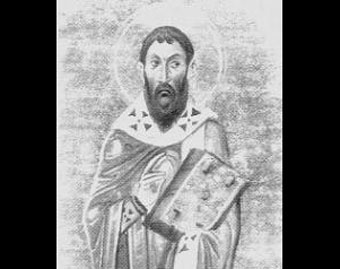
by Benjamin Mann
.- A courageous leader of the Jerusalem Church during the Islamic conquests of the seventh century, Patriarch Saint Sophronius I has his liturgical memorial on March 11. Though he is acknowledged and celebrated as a saint in the Roman Catholic Church, St. Sophronius is more commonly venerated among Eastern Catholics and within the Eastern Orthodox churches. All of these traditions commemorate him on the same date, the purported date of his death in 638.
Born in Damascus, Syria, around the year 560, Sophronius came from an esteemed family and received a deep philosophical education. His early devotion to God grew into an inclination toward monastic life, and while still young he entered a monastery in Palestine. He became a friend and student of John Moschus, his fellow monk who would become an important spiritual writer in the Eastern Christian tradition. The Zoroastrian Persians – long-standing military rivals of the Byzantine Empire, hailing from present-day Iran – invaded Palestine in 605. As a result the two monks fled first to Antioch and then Egypt. But their flight became a spiritual quest, taking John and Sophronius to many monasteries throughout the Middle East. Moschus’ memoir of their travels, entitled “The Spiritual Meadow,” survives and is still read in the Church to this day.
The two monks' foremost patron was Saint John the Almsgiver, patriarch of Alexandria, with whom they stayed for a time until the Persians conquered the city in 614. The Zoroastrian invasion of Egypt forced the kindly patriarch back to his homeland of Cyprus, while Sophronius and John Moschus took refuge in Rome along with a group of other monks. Moschus, regarded as a saint by some contemporary Eastern Christians, died in Rome during 619.
Jerusalem, the future site of Sophronius’ patriarchate, was the subject of violent disputes even before the rise of Islam. Captured by the Persians in 614, it was not retaken by the Byzantines until 628. The Christian reconquest of the city was triumphant, after the long wars with the Zoroastrian empire. But the triumph would be short-lived: By that time the Islamic founder Muhammad had begun his conquests, which would continue under his successors the caliphs.
Eastern Christendom also suffered internally during the 620s, with a recurrence of doctrinal controversy over the person of Christ. During the 630s, Sophronius prominently opposed the “monothelite” heresy – whose adherents supposed Jesus had only one will, the divine. This error denied Christ’s human will, making him less than “true God and true man.” Saint Maximus the Confessor, the greatest opponent of monothelitism, was taught and mentored by Sophronius.
Chosen to lead the Church in Jerusalem during 634, Sophronius continued to oppose the monothelite heresy. But he soon faced a more tangible threat from Caliph Umar and his army of followers. The Muslims beseiged Jerusalem for two years during Sophronius’ patriarchate, forcibly depriving the city’s residents of food. The patriarch could only save the lives of his people by negotiating a surrender with the caliph. Thus, Jerusalem fell to Islam for the first time in 637. Heartbroken, St. Sophronius died the following year.
Patriarch St. Sophronius' stand against monothelitism was vindicated near the end of the seventh century, when the heresy of “one will” in Christ received formal condemnation at the Sixth Ecumenical Council in Constantinople. But the Jerusalem Patriarchate remained vacant for many decades after St. Sophronius’ death: a successor was not appointed until 705. Jerusalem, meanwhile, would not pass back into Christian hands until the First Crusade of 1099.